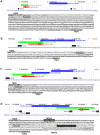Human miRNA precursors with box H/ACA snoRNA features
- PMID: 19763159
- PMCID: PMC2730528
- DOI: 10.1371/journal.pcbi.1000507
Human miRNA precursors with box H/ACA snoRNA features
Abstract
MicroRNAs (miRNAs) and small nucleolar RNAs (snoRNAs) are two classes of small non-coding regulatory RNAs, which have been much investigated in recent years. While their respective functions in the cell are distinct, they share interesting genomic similarities, and recent sequencing projects have identified processed forms of snoRNAs that resemble miRNAs. Here, we investigate a possible evolutionary relationship between miRNAs and box H/ACA snoRNAs. A comparison of the genomic locations of reported miRNAs and snoRNAs reveals an overlap of specific members of these classes. To test the hypothesis that some miRNAs might have evolved from snoRNA encoding genomic regions, reported miRNA-encoding regions were scanned for the presence of box H/ACA snoRNA features. Twenty miRNA precursors show significant similarity to H/ACA snoRNAs as predicted by snoGPS. These include molecules predicted to target known ribosomal RNA pseudouridylation sites in vivo for which no guide snoRNA has yet been reported. The predicted folded structures of these twenty H/ACA snoRNA-like miRNA precursors reveal molecules which resemble the structures of known box H/ACA snoRNAs. The genomic regions surrounding these predicted snoRNA-like miRNAs are often similar to regions around snoRNA retroposons, including the presence of transposable elements, target site duplications and poly (A) tails. We further show that the precursors of five H/ACA snoRNA-like miRNAs (miR-151, miR-605, mir-664, miR-215 and miR-140) bind to dyskerin, a specific protein component of functional box H/ACA small nucleolar ribonucleoprotein complexes suggesting that these molecules have retained some H/ACA snoRNA functionality. The detection of small RNA molecules that share features of miRNAs and snoRNAs suggest that these classes of RNA may have an evolutionary relationship.
Conflict of interest statement
The authors have declared that no competing interests exist.
Figures






References
-
- Kiss T. Small nucleolar RNAs: an abundant group of noncoding RNAs with diverse cellular functions. Cell. 2002;109:145–148. - PubMed
-
- Bachellerie JP, Cavaille J, Huttenhofer A. The expanding snoRNA world. Biochimie. 2002;84:775–790. - PubMed
-
- Filipowicz W, Pogacic V. Biogenesis of small nucleolar ribonucleoproteins. Curr Opin Cell Biol. 2002;14:319–327. - PubMed
-
- Tycowski KT, Aab A, Steitz JA. Guide RNAs with 5′ caps and novel box C/D snoRNA-like domains for modification of snRNAs in metazoa. Curr Biol. 2004;14:1985–1995. - PubMed
-
- Lai EC. miRNAs: whys and wherefores of miRNA-mediated regulation. Curr Biol. 2005;15:R458–460. - PubMed
Publication types
MeSH terms
Substances
Grants and funding
LinkOut - more resources
Full Text Sources
Other Literature Sources

